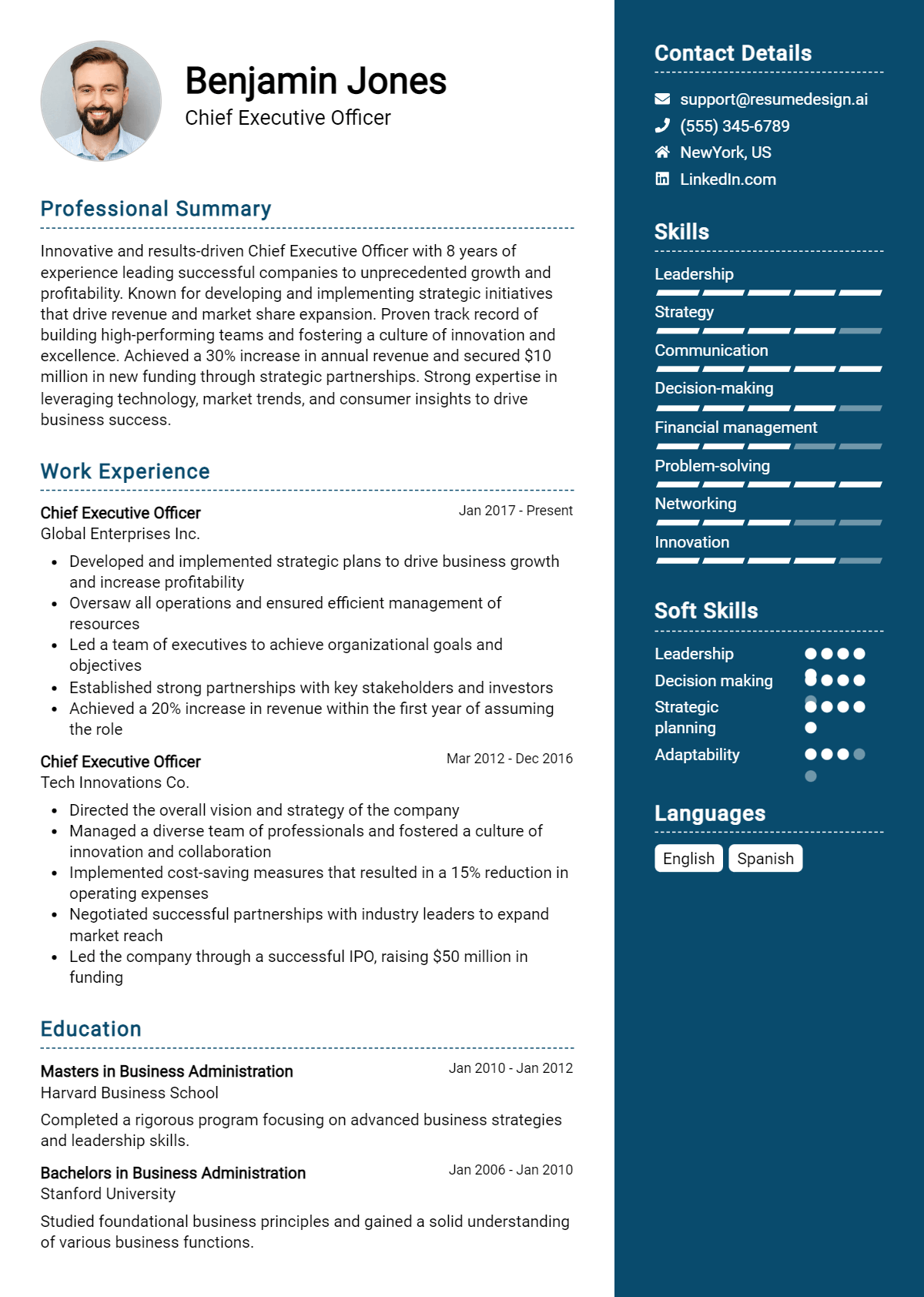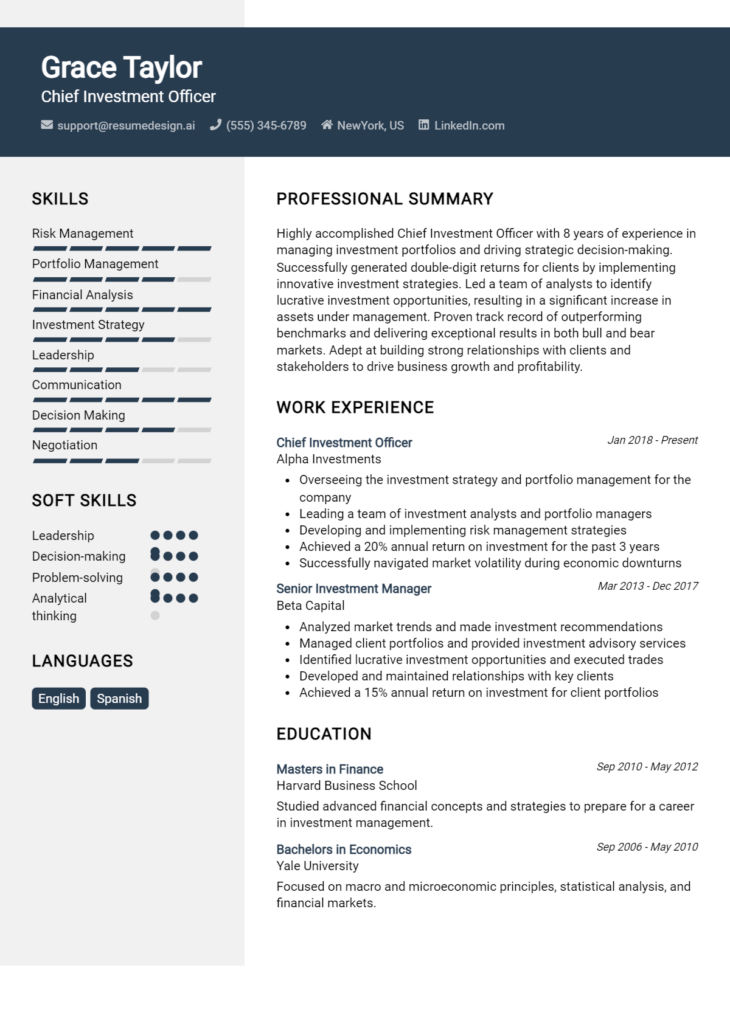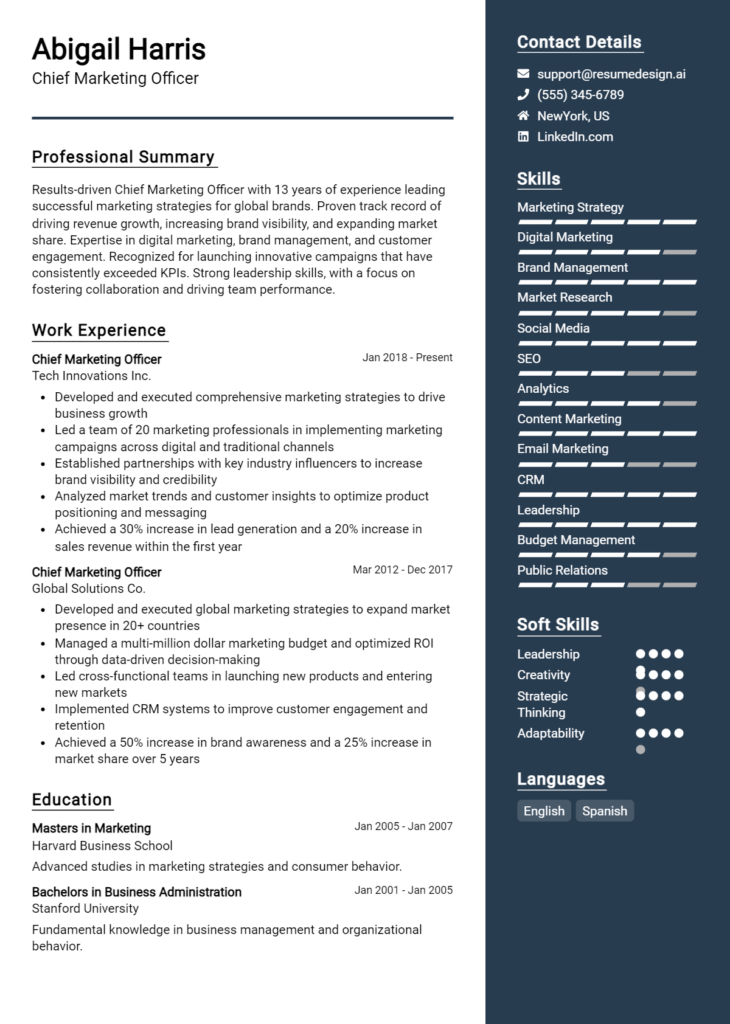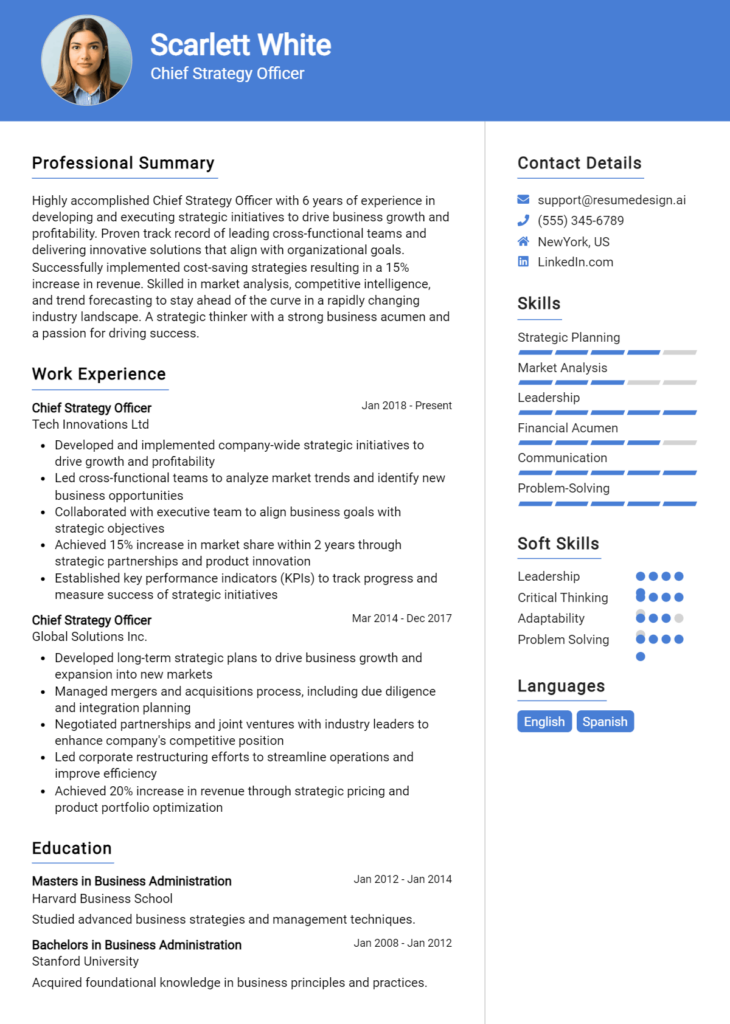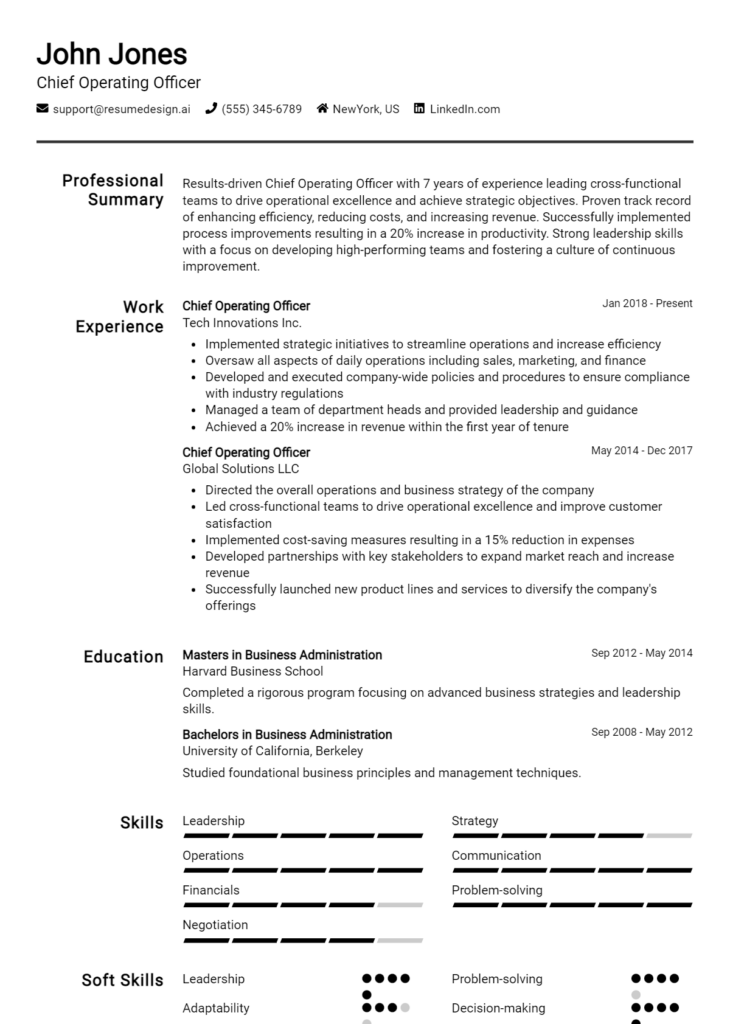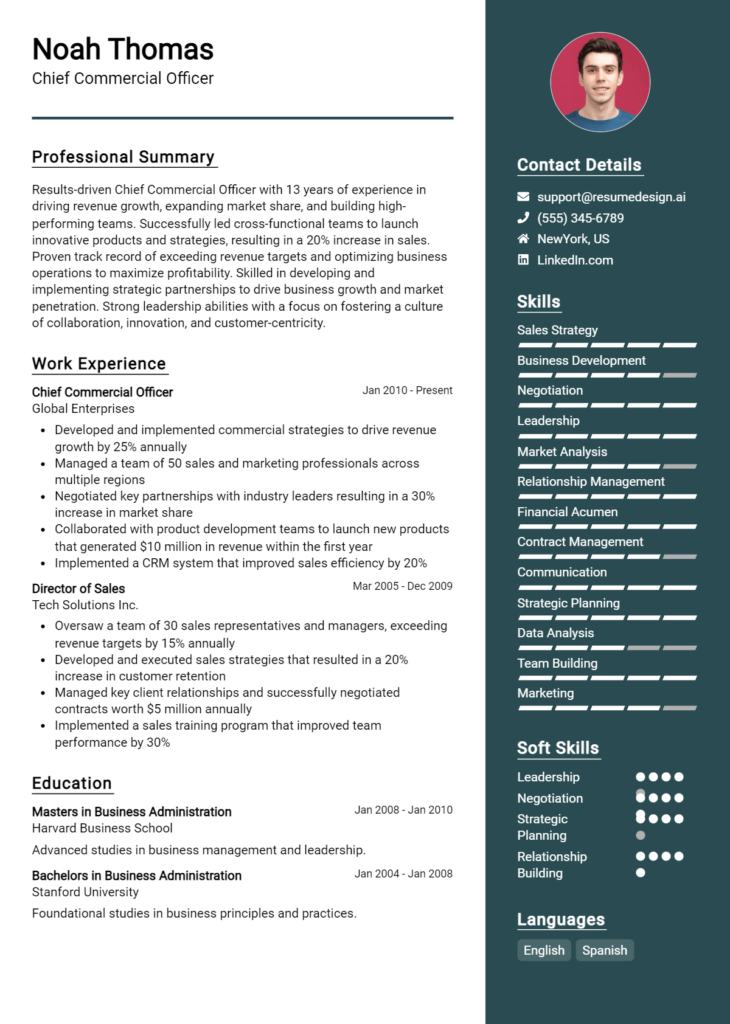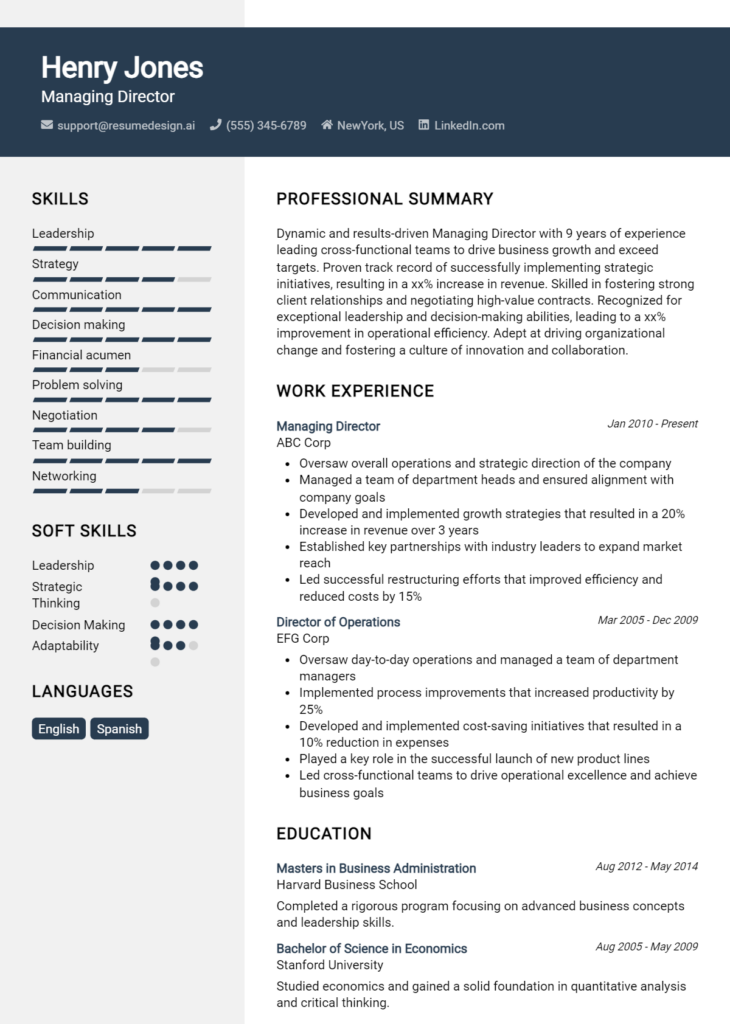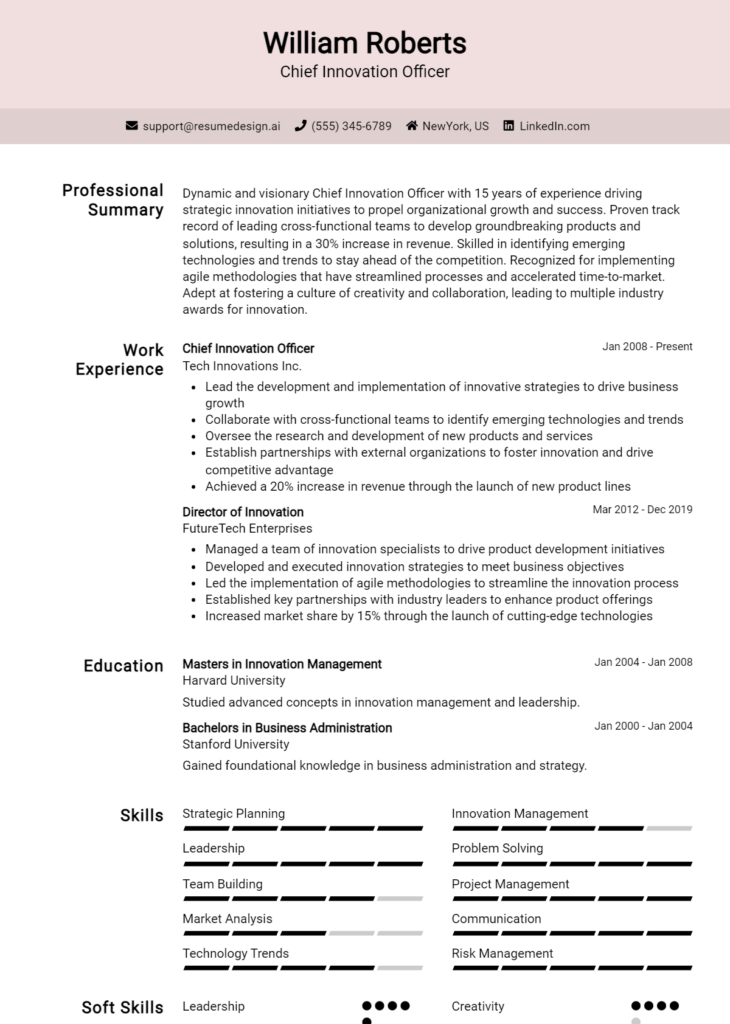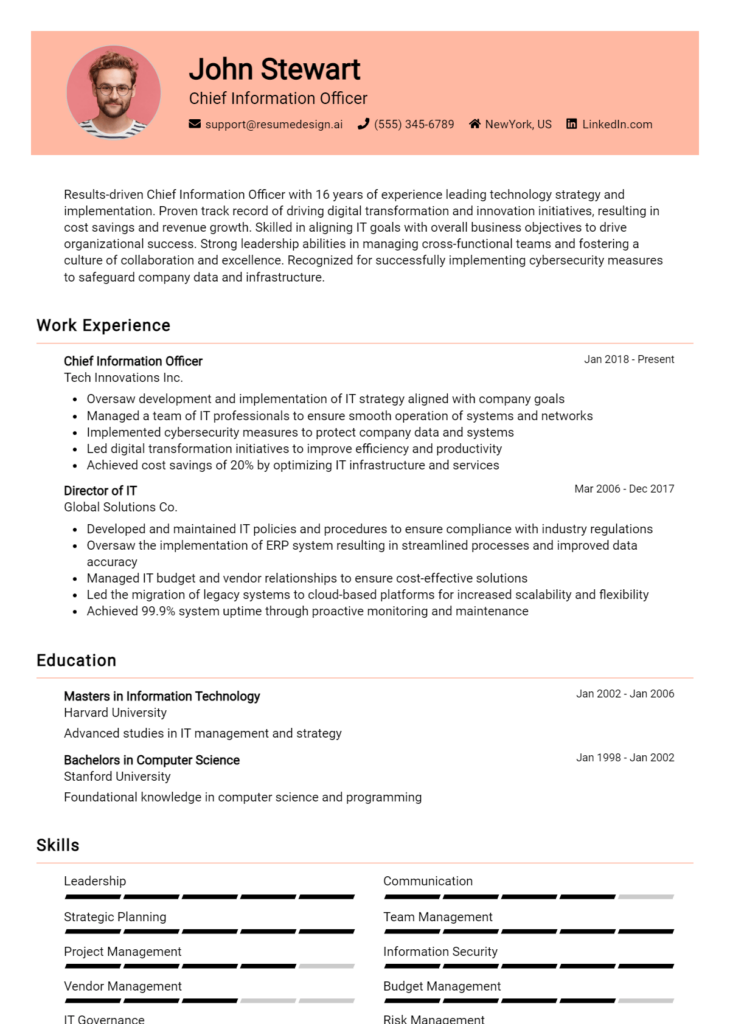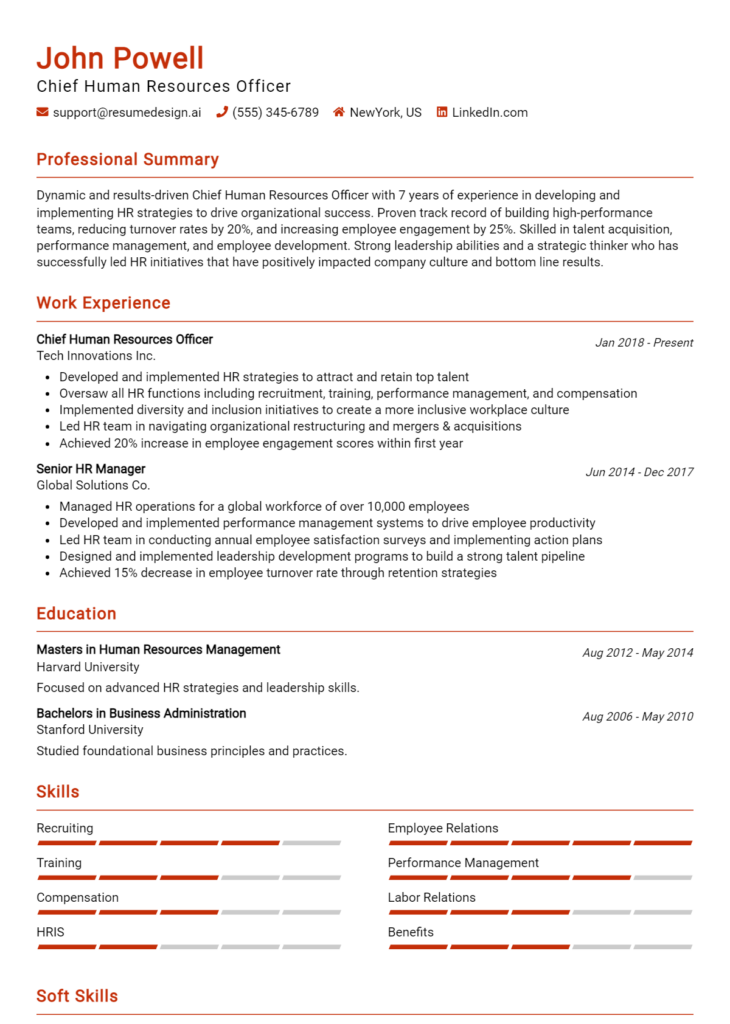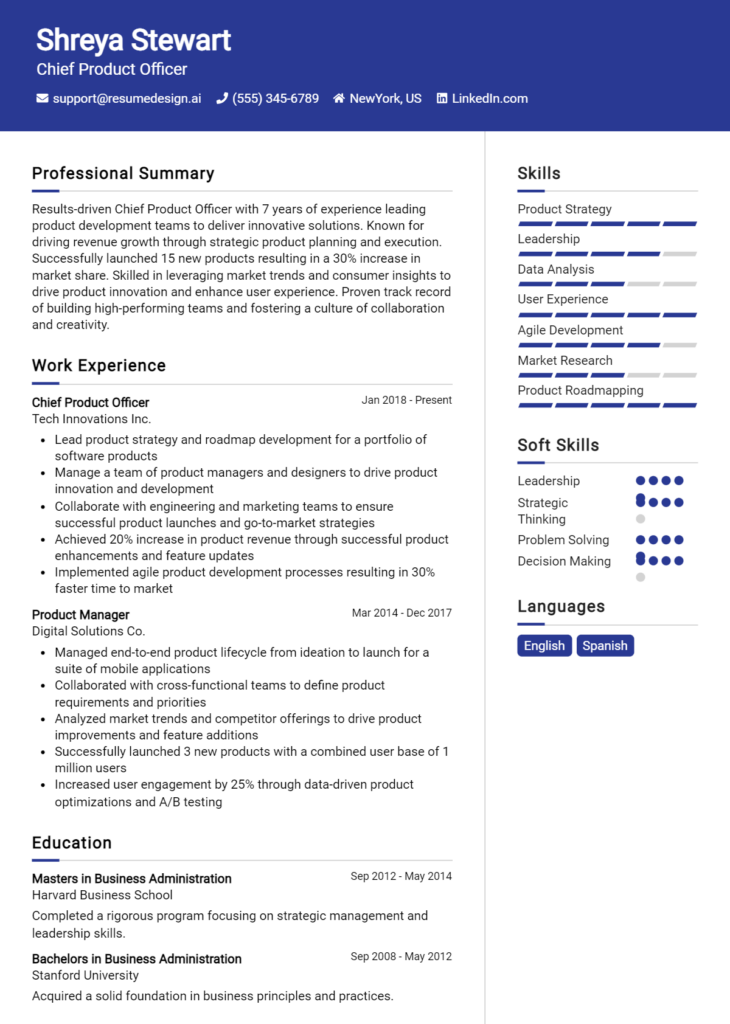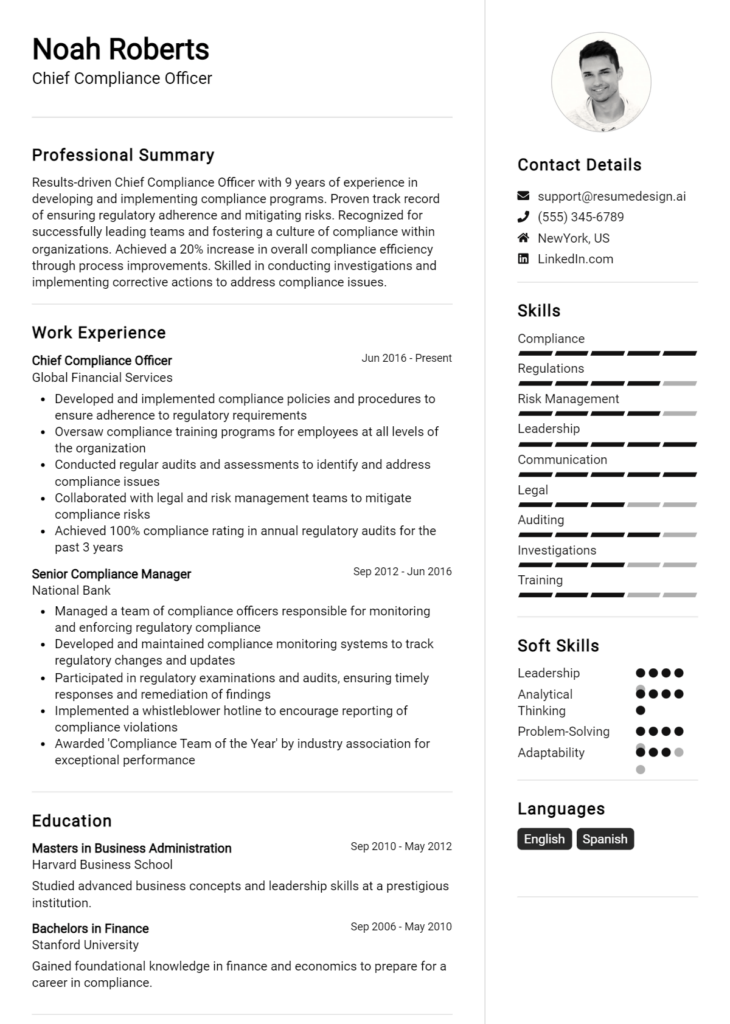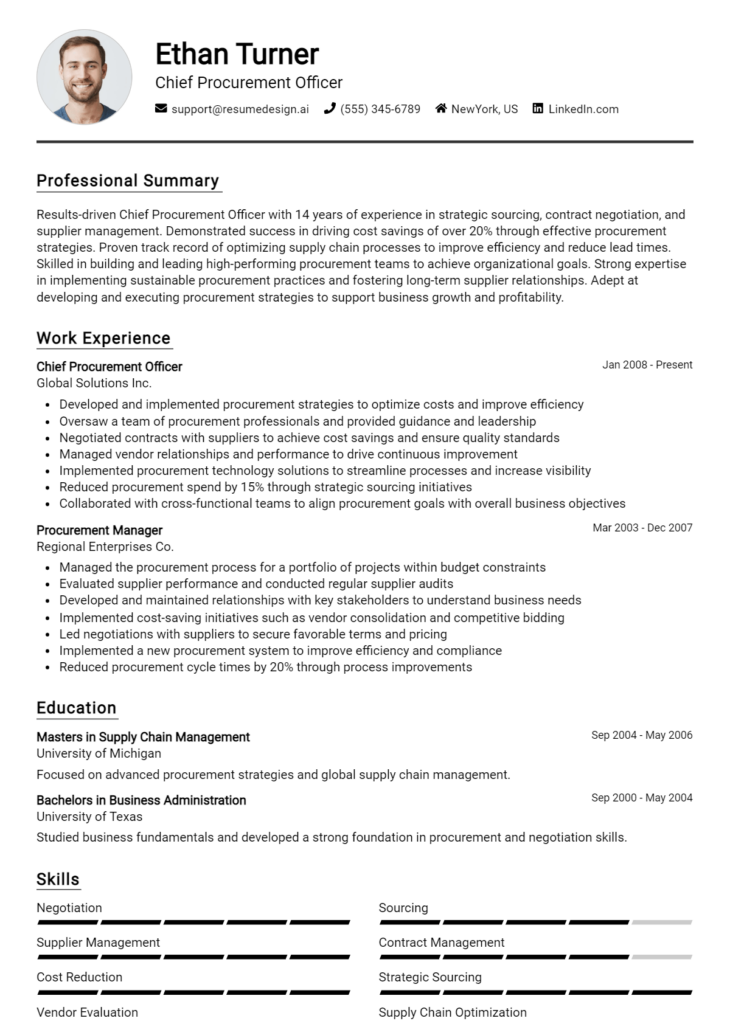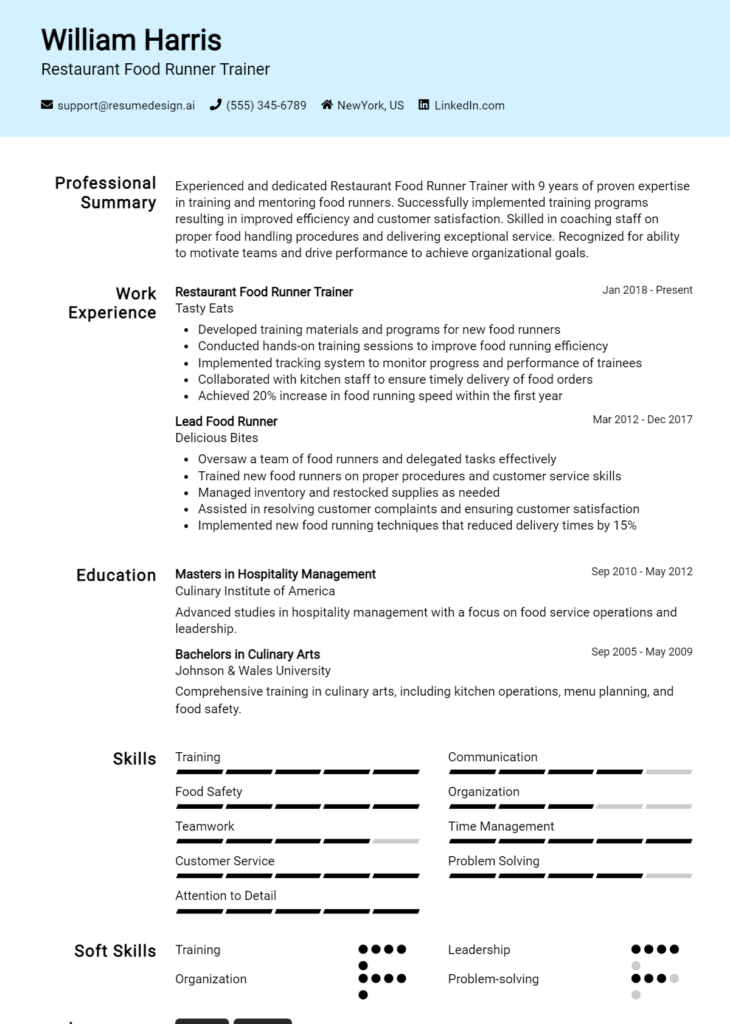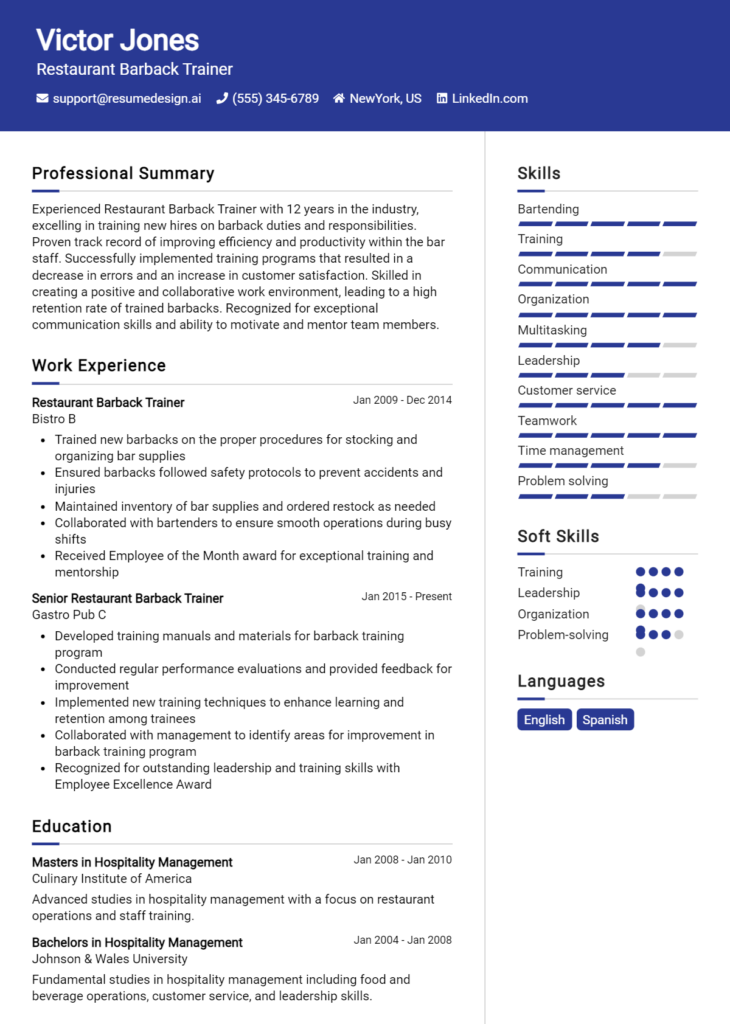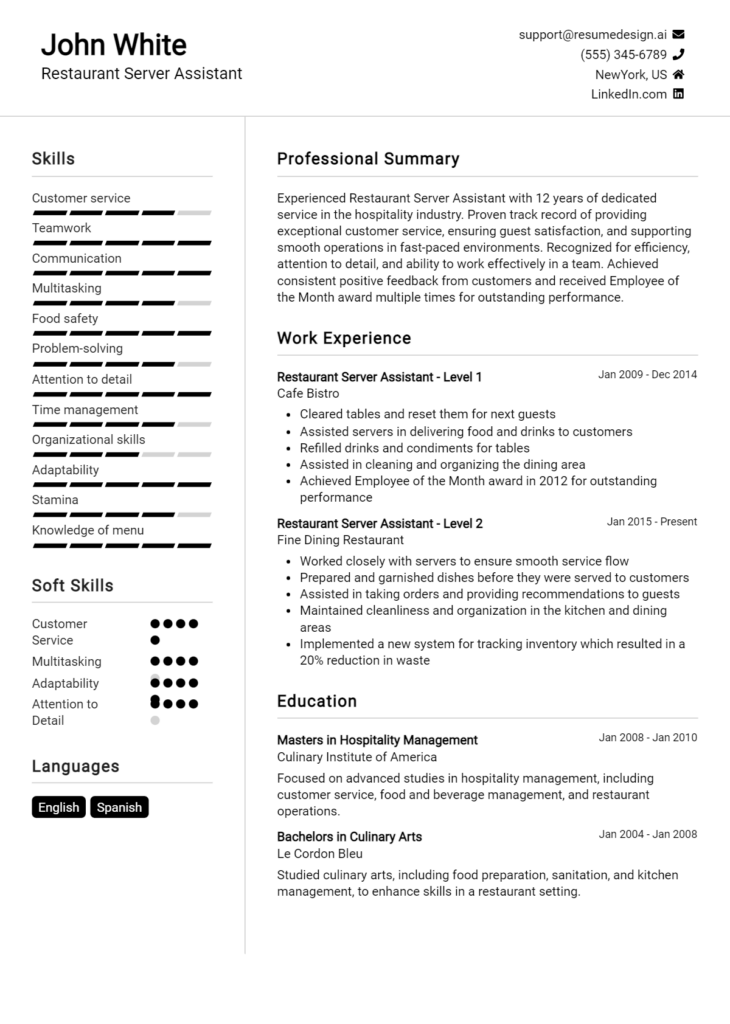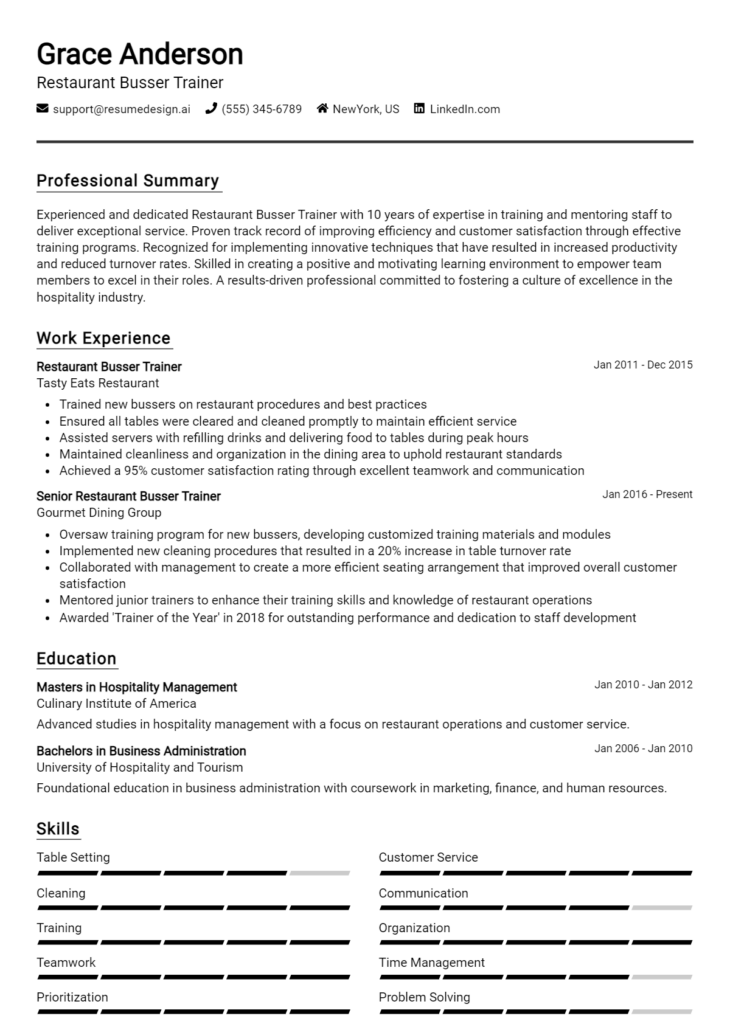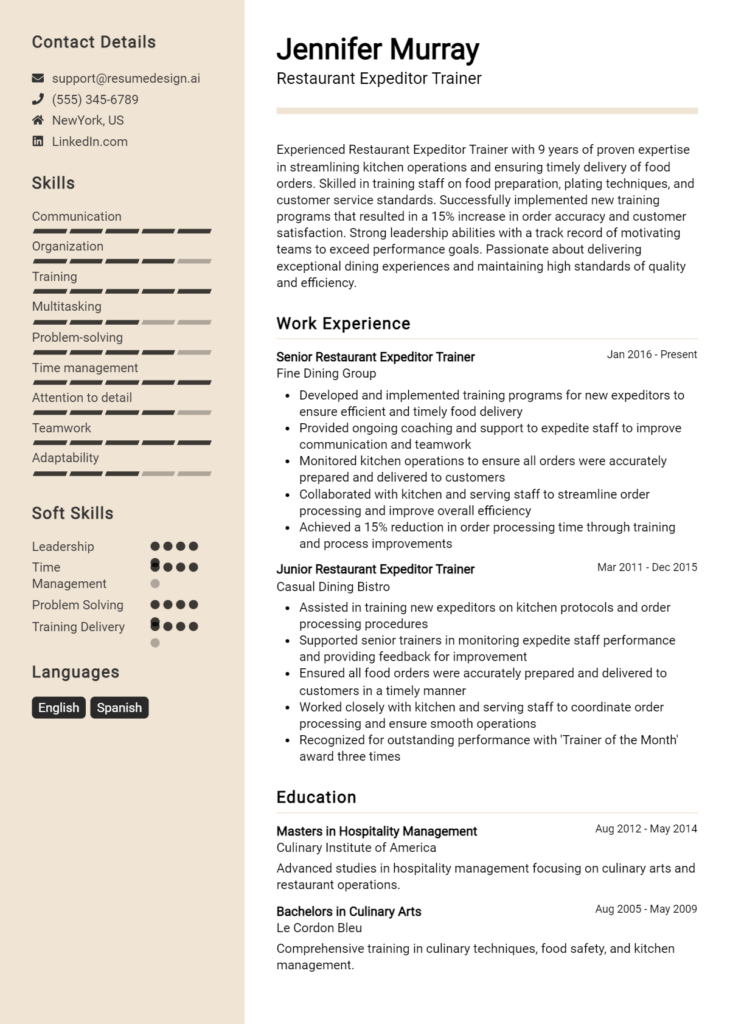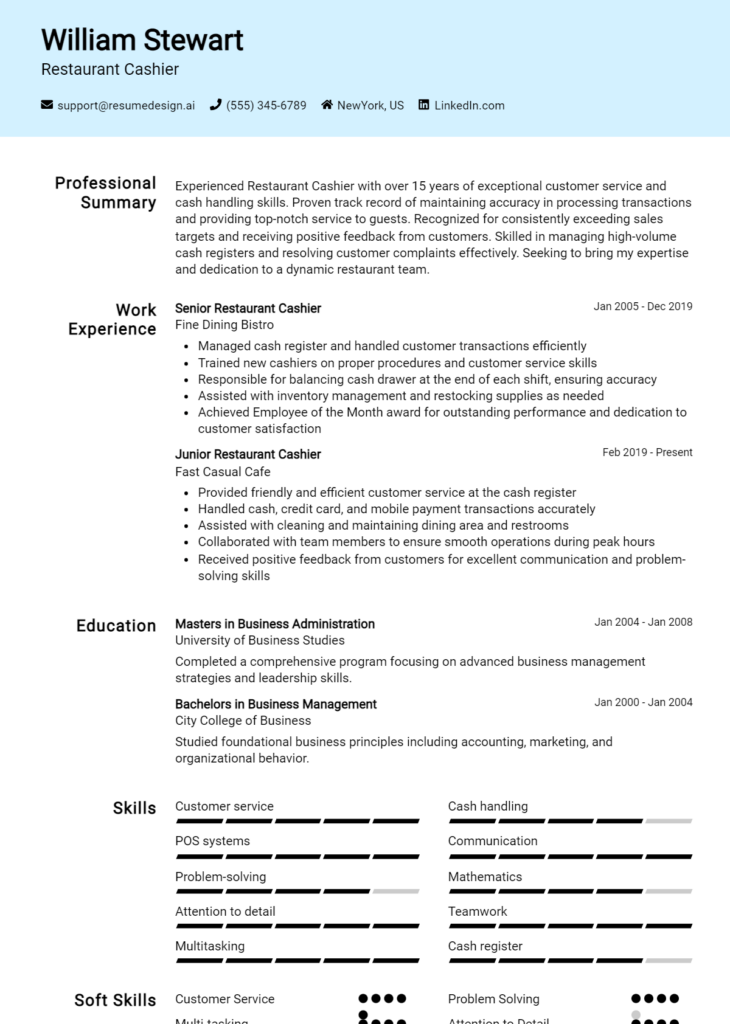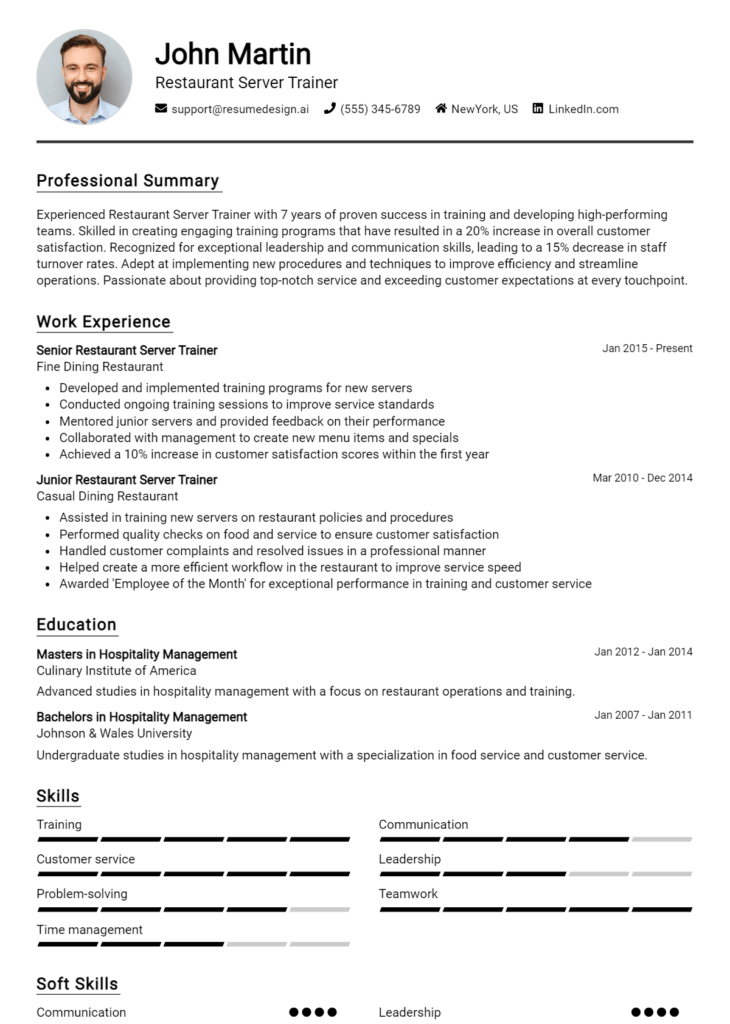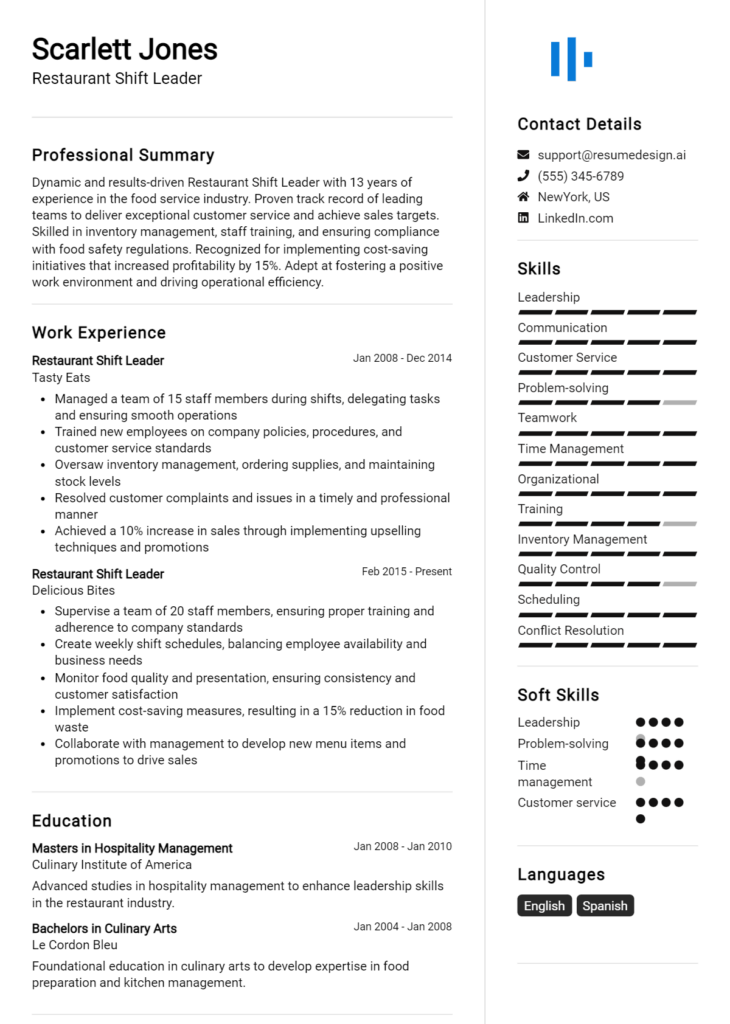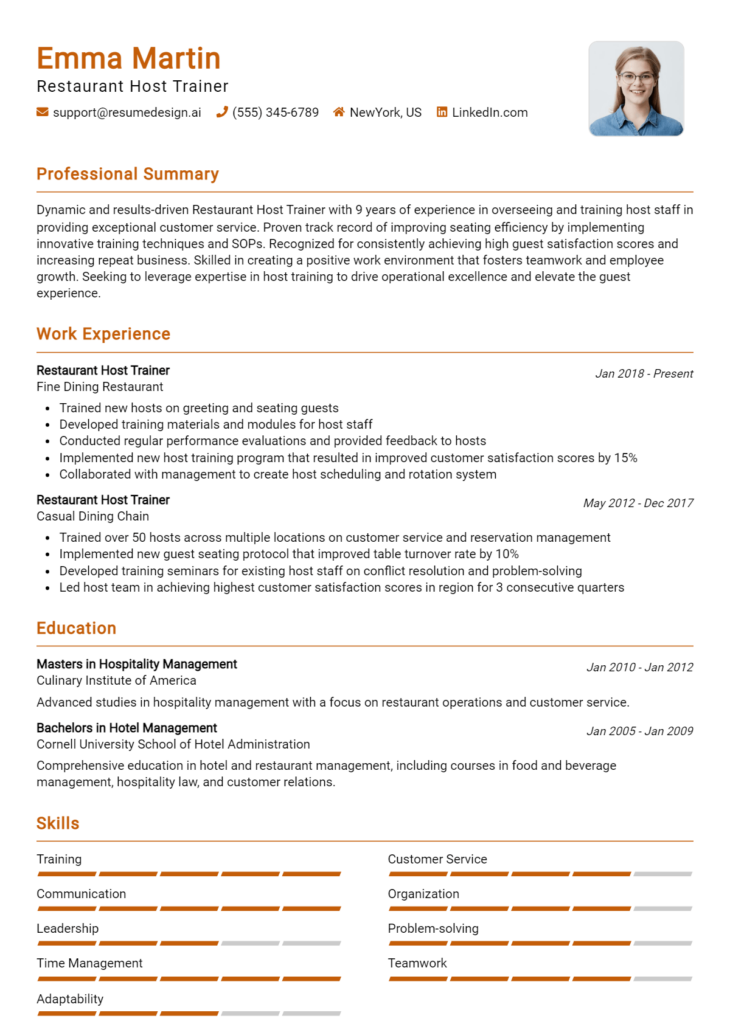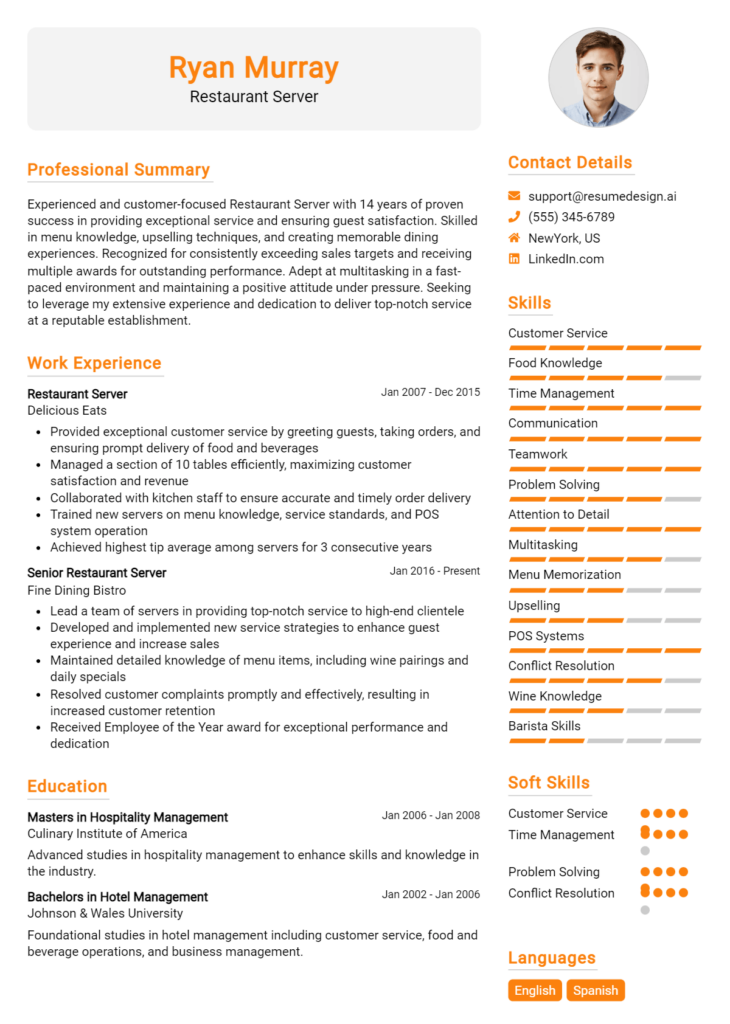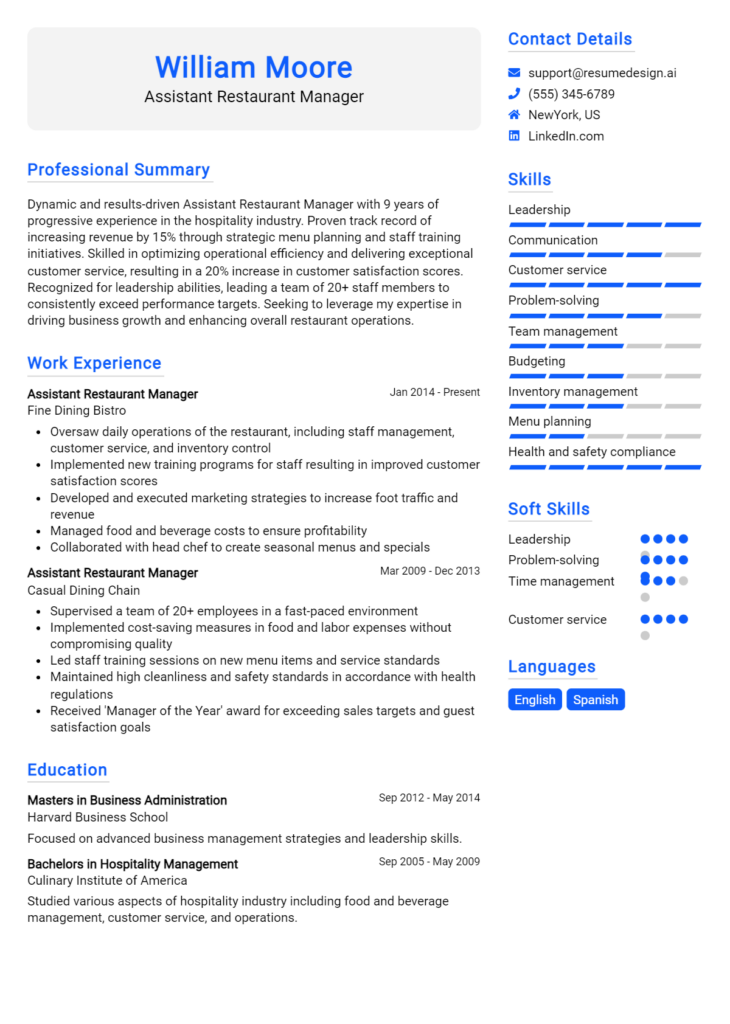Chief Executive Officer Core Responsibilities
The Chief Executive Officer (CEO) plays a pivotal role in an organization by bridging various departments, ensuring cohesive operations across all functions. Key responsibilities include strategic planning, decision-making, and resource allocation, requiring strong technical, operational, and problem-solving skills. A successful CEO aligns the organization’s objectives with its overall vision, fostering collaboration and innovation. Highlighting these competencies on a well-structured resume is essential to demonstrate the ability to drive growth and achieve organizational goals.
Common Responsibilities Listed on Chief Executive Officer Resume
- Develop and implement organizational strategies to achieve business objectives.
- Oversee company operations and ensure efficiency across departments.
- Lead senior management and provide guidance to department heads.
- Establish and maintain relationships with stakeholders, including clients and investors.
- Monitor market trends and adapt business strategies accordingly.
- Ensure compliance with legal and regulatory requirements.
- Manage financial performance and prepare budgets.
- Drive company culture and promote values among employees.
- Represent the company at public events and in media relations.
- Evaluate and mitigate risks to the organization.
- Foster innovation and encourage continuous improvement.
High-Level Resume Tips for Chief Executive Officer Professionals
In today's competitive job market, a well-crafted resume is essential for Chief Executive Officer (CEO) professionals looking to make a lasting impression. As the first point of contact between candidates and potential employers, the resume serves as a powerful marketing tool that not only showcases a candidate's skills and experiences but also reflects their leadership capabilities and vision for success. A strong resume should effectively communicate the unique value a CEO can bring to an organization, making it crucial to highlight key achievements and relevant expertise. This guide will provide practical and actionable resume tips specifically tailored for Chief Executive Officer professionals, ensuring that candidates can present themselves in the best possible light.
Top Resume Tips for Chief Executive Officer Professionals
- Tailor your resume to align with the job description, emphasizing the most relevant experiences and skills that meet the employer's specific needs.
- Showcase your leadership experience by highlighting previous roles where you successfully led teams, managed budgets, or drove strategic initiatives.
- Quantify your achievements with specific metrics, such as revenue growth percentages, cost reductions, or successful project completions, to demonstrate your impact.
- Focus on industry-specific skills and knowledge that are pertinent to the organization you are applying to, showcasing your understanding of market trends and challenges.
- Utilize a clear and professional format that enhances readability and draws attention to key sections, such as your career summary and major accomplishments.
- Incorporate powerful action verbs to describe your responsibilities and achievements, conveying a sense of proactivity and leadership.
- Include a compelling executive summary at the top of your resume that encapsulates your vision, leadership philosophy, and the unique value you bring.
- Highlight any board memberships or community involvement to showcase your commitment to governance and social responsibility.
- Keep your resume concise, ideally within 2 pages, focusing on the most impactful information without unnecessary details.
By implementing these tips, Chief Executive Officer professionals can significantly enhance their resumes, increasing their chances of landing interviews and ultimately securing the job they aspire to. A well-structured and compelling resume not only conveys qualifications but also demonstrates a candidate's readiness to lead and inspire in a high-stakes role.
Why Resume Headlines & Titles are Important for Chief Executive Officer
In the competitive landscape of executive recruitment, a Chief Executive Officer (CEO) must stand out, and one of the most effective ways to achieve this is through powerful resume headlines and titles. A strong headline acts as a hook, immediately capturing the attention of hiring managers and succinctly summarizing a candidate's key qualifications in a single impactful phrase. It should encapsulate the essence of the candidate's experience and expertise while remaining concise, relevant, and directly aligned with the specific job being applied for. A compelling headline sets the tone for the entire resume, making it an indispensable component of a successful job application.
Best Practices for Crafting Resume Headlines for Chief Executive Officer
- Keep it concise: Aim for a headline that is brief yet informative, ideally no more than 10-15 words.
- Be role-specific: Tailor the headline to reflect the specific CEO role you are applying for, incorporating relevant keywords.
- Highlight key strengths: Focus on your most impressive skills, accomplishments, or areas of expertise that align with the position.
- Use action-oriented language: Employ strong verbs that convey leadership, innovation, and strategic vision.
- Avoid jargon: Ensure the language is accessible and avoids overly technical or industry-specific terms that may confuse the reader.
- Showcase unique value: Differentiate yourself by highlighting what makes you an exceptional candidate for the CEO role.
- Prioritize clarity: The headline should be straightforward, allowing hiring managers to quickly grasp your qualifications.
- Test different variations: Experiment with different headlines to see which one resonates best with your target audience.
Example Resume Headlines for Chief Executive Officer
Strong Resume Headlines
Transformational CEO Driving Revenue Growth and Operational Excellence
Visionary Leader with 20+ Years in Global Market Expansion and Innovation
Dynamic Executive Specializing in Strategic Partnerships and Sustainable Growth
Weak Resume Headlines
Experienced Executive Looking for Opportunities
CEO with Various Skills and Experience
The strong resume headlines are effective because they are specific, highlighting the candidate's unique strengths and aligning them directly with the expectations of the CEO role. They use impactful language that showcases leadership qualities and achievements, making a lasting impression on hiring managers. In contrast, the weak headlines fail to impress due to their vagueness and lack of specificity, providing no clear indication of what the candidate brings to the table. This lack of detail can make it difficult for hiring managers to see the value in the application, leading to missed opportunities for qualified candidates.
Writing an Exceptional Chief Executive Officer Resume Summary
A resume summary is a crucial component for a Chief Executive Officer (CEO) application, as it serves as the first impression for hiring managers. In a competitive job market, a strong summary quickly captures attention by highlighting key skills, extensive experience, and significant accomplishments relevant to the role. It is essential that this summary is concise, impactful, and specifically tailored to the job the candidate is applying for, demonstrating how the candidate's leadership can drive the organization forward.
Best Practices for Writing a Chief Executive Officer Resume Summary
- Quantify Achievements: Use numbers and statistics to highlight your successes, such as revenue growth percentages or cost reductions.
- Focus on Leadership Skills: Emphasize your ability to lead teams, drive strategy, and inspire innovation.
- Tailor to the Job Description: Customize your summary to reflect the key qualifications and requirements outlined in the job posting.
- Highlight Industry Experience: Mention your relevant experience in the specific industry to establish credibility.
- Use Powerful Language: Choose strong, action-oriented verbs to convey confidence and decisiveness.
- Keep it Concise: Aim for 3-5 sentences that deliver a powerful message without overwhelming the reader.
- Showcase Problem-Solving Abilities: Illustrate how you've effectively addressed challenges and contributed to organizational success.
Example Chief Executive Officer Resume Summaries
Strong Resume Summaries
Dynamic CEO with over 15 years of experience in the tech sector, driving revenue growth by 200% through innovative product launches and strategic partnerships. Proven track record in leading cross-functional teams to exceed performance targets and enhance operational efficiency.
Results-oriented Chief Executive Officer with a history of transforming underperforming companies into market leaders. Achieved a 50% increase in annual profits within two years by implementing a comprehensive restructuring plan and fostering a culture of accountability.
Visionary leader with expertise in global market expansion, having successfully entered three new international markets that contributed to a 30% growth in company revenue. Skilled in stakeholder engagement and building high-performing teams.
Weak Resume Summaries
Experienced professional looking for a CEO position. I have worked in various industries and have some leadership experience.
I am a Chief Executive Officer who believes in teamwork and has a lot of knowledge about running a business.
The examples provided demonstrate a clear distinction between strong and weak resume summaries. Strong summaries effectively showcase quantifiable results, specific leadership skills, and direct relevance to the CEO role, making them compelling to hiring managers. In contrast, weak summaries lack detail, specificity, and measurable outcomes, which can fail to engage potential employers and may lead to missed opportunities.
Work Experience Section for Chief Executive Officer Resume
The work experience section is a critical component of a Chief Executive Officer's resume, serving as a platform to demonstrate the candidate's technical skills, leadership capabilities, and successful track record in driving business results. This section offers a unique opportunity to illustrate how the candidate has effectively managed teams, implemented strategic initiatives, and delivered high-quality products or services. By quantifying achievements and aligning previous experiences with industry standards, candidates can showcase their value to potential employers, making it clear how their expertise can contribute to organizational success.
Best Practices for Chief Executive Officer Work Experience
- Focus on quantifiable achievements, such as revenue growth, cost reductions, or market expansion.
- Highlight technical expertise relevant to the industry, including specific technologies, methodologies, or frameworks.
- Emphasize leadership roles where you successfully managed teams or projects, showcasing your ability to inspire and guide others.
- Use action verbs to convey a sense of proactivity and impact in your roles.
- Align your experiences with industry standards and best practices to demonstrate your familiarity with the sector.
- Incorporate testimonials or endorsements from board members or key stakeholders to add credibility.
- Focus on collaborative projects that led to significant outcomes, illustrating your ability to work cross-functionally.
- Keep descriptions concise while ensuring they capture the essence of your contributions and results.
Example Work Experiences for Chief Executive Officer
Strong Experiences
- Led a cross-functional team that achieved a 30% increase in annual revenue through the implementation of a new market strategy, resulting in $5 million in additional sales.
- Directed a successful product launch that captured a 20% market share within the first year, leveraging innovative technology solutions and strategic partnerships.
- Implemented a company-wide operational efficiency program that reduced costs by 15%, enhancing profitability and improving cash flow management.
- Collaborated with the executive team to develop a five-year strategic plan that increased employee engagement scores by 40% and reduced turnover by 25%.
Weak Experiences
- Managed various teams and projects without clear outcomes or metrics.
- Was responsible for several initiatives that did not lead to significant changes or improvements.
- Participated in meetings and discussions about strategy, but did not contribute to actionable results.
- Oversaw operations with general statements and no specific achievements or impact.
The examples outlined above are considered strong or weak based on their clarity and impact. Strong experiences are characterized by specific, quantifiable outcomes that demonstrate leadership and technical expertise, while weak experiences lack detail and fail to show measurable results. Candidates should aim to craft their work experiences in a way that articulates their contributions and highlights their ability to drive business success.
Education and Certifications Section for Chief Executive Officer Resume
The education and certifications section of a Chief Executive Officer (CEO) resume plays a vital role in showcasing a candidate's academic foundation and commitment to professional development. This section not only highlights the candidate's educational achievements, but it also emphasizes any industry-relevant certifications and ongoing learning initiatives that align with the dynamic nature of executive leadership. By providing details on relevant coursework, recognized certifications, and specialized training, candidates can enhance their credibility and demonstrate their preparedness for the demands of the CEO role. A well-structured education and certifications section can significantly influence hiring decisions, showcasing a candidate’s ability to drive organizational success through informed leadership.
Best Practices for Chief Executive Officer Education and Certifications
- Prioritize relevance by including degrees and certifications that directly relate to leadership, management, and the specific industry.
- Provide detailed information about advanced degrees, such as an MBA or relevant master's programs, to underscore your expertise.
- Highlight industry-recognized certifications like Certified Executive Coach (CEC) or Project Management Professional (PMP) to validate your skills.
- Include relevant coursework that demonstrates knowledge in areas such as finance, strategic management, and organizational behavior.
- Keep the format clear and concise, making it easy for hiring managers to assess qualifications at a glance.
- Stay current by updating this section with any new certifications or training completed to show commitment to continuous professional development.
- Consider listing leadership training or workshops attended to demonstrate your proactive approach to enhancing your leadership capabilities.
- Use bullet points for clarity and to draw attention to key qualifications, making the section easily scannable.
Example Education and Certifications for Chief Executive Officer
Strong Examples
- MBA in Business Administration, Harvard Business School, 2010
- Certified Executive Coach (CEC), International Coach Federation, 2015
- Certification in Strategic Management, Wharton School of Business, 2018
- Leadership Development Program, Stanford University, 2021
Weak Examples
- Bachelor of Arts in English Literature, State University, 2005
- Basic Excel Certification, Online platform, 2019
- High School Diploma, Local High School, 2000
- Certificate of Participation in a Community Workshop, 2020
The examples listed above are considered strong because they reflect advanced degrees and certifications that are highly relevant to the role of a Chief Executive Officer, demonstrating a commitment to leadership and strategic thinking. In contrast, the weak examples highlight educational qualifications and certifications that lack relevance to the executive level, such as a general high school diploma or unrelated coursework, which do not support the candidate’s aspirations for a CEO position. This distinction showcases the importance of aligning educational qualifications with the requirements of senior leadership roles.
Top Skills & Keywords for Chief Executive Officer Resume
As a Chief Executive Officer (CEO), possessing the right blend of skills is crucial for leading an organization toward success. A well-crafted resume should highlight both hard and soft skills that demonstrate your ability to navigate the complexities of business management and inspire teams. Skills not only showcase your qualifications but also reflect your leadership capabilities, strategic thinking, and adaptability in a rapidly changing market. Whether you're emphasizing your visionary approach or your analytical prowess, these skills can significantly impact how potential employers perceive your candidacy. For a deeper understanding of the skills that can elevate your resume, explore our resource on skills and how to articulate your work experience.
Top Hard & Soft Skills for Chief Executive Officer
Soft Skills
- Strategic Thinking
- Effective Communication
- Leadership and Team Building
- Problem Solving
- Emotional Intelligence
- Decision Making
- Negotiation Skills
- Adaptability
- Conflict Resolution
- Visionary Leadership
- Networking and Relationship Management
- Time Management
- Cultural Awareness
- Mentorship and Coaching
- Resilience
Hard Skills
- Financial Acumen
- Business Development
- Market Analysis
- Risk Management
- Operations Management
- Project Management
- Data Analysis and Interpretation
- Compliance and Regulatory Knowledge
- Performance Metrics and KPIs
- Technology Savvy
- Strategic Planning
- Budgeting and Forecasting
- Sales and Marketing Strategy
- Supply Chain Management
- Change Management
- Mergers and Acquisitions Expertise
- Industry-Specific Knowledge
Stand Out with a Winning Chief Executive Officer Cover Letter
As an accomplished leader with over 15 years of experience driving strategic vision and operational excellence in dynamic environments, I am excited to apply for the Chief Executive Officer position at [Company Name]. My track record of transforming organizations, enhancing profitability, and cultivating high-performance cultures aligns perfectly with your ambitious goals. I am particularly drawn to [Company Name] because of its commitment to innovation and sustainability, values that resonate deeply with my professional ethos.
Throughout my career, I have successfully led diverse teams to achieve remarkable outcomes. For instance, at [Previous Company Name], I spearheaded a major restructuring initiative that resulted in a 30% increase in operational efficiency and a 25% boost in revenue within two years. I believe that a collaborative approach is key to unlocking potential, and I prioritize fostering an inclusive environment where every team member feels valued and empowered to contribute their best. I am eager to bring this same passion for leadership and teamwork to [Company Name].
In addition to my operational expertise, I have a proven ability to navigate complex market landscapes and forge strategic partnerships that drive growth. I am adept at leveraging data-driven insights to inform decision-making and enhance competitive positioning. As we look toward a future marked by rapid change, I am committed to ensuring that [Company Name] not only adapts but thrives, capitalizing on new opportunities while remaining steadfast in its mission and values.
I am enthusiastic about the possibility of leading [Company Name] into its next chapter of success. I welcome the opportunity to discuss how my experience, vision, and leadership style can contribute to your esteemed organization. Thank you for considering my application; I look forward to the possibility of collaborating with your team to achieve shared goals.
Common Mistakes to Avoid in a Chief Executive Officer Resume
When crafting a resume for a Chief Executive Officer position, it's crucial to present your experience and skills in a way that resonates with potential employers. However, many candidates fall into common pitfalls that can undermine their chances of landing an interview. Recognizing and avoiding these mistakes can significantly enhance the effectiveness of your resume. Here are some of the most frequent missteps to watch out for:
Vague Job Descriptions: Failing to provide specific details about your responsibilities and achievements can make your experience seem less impactful. Use quantifiable results to demonstrate your contributions.
Overly Long Resumes: A lengthy resume can overwhelm recruiters. Aim for a concise document that highlights the most relevant information—ideally, no more than two pages.
Neglecting Leadership Accomplishments: As a CEO, your leadership is key. Don't just list duties; instead, focus on your achievements in driving change, growth, and innovation within the organization.
Ignoring Industry-Specific Language: Using jargon or terminology that is specific to your industry can help you connect with recruiters. Tailor your resume to reflect the language and trends relevant to the sector you are targeting.
Lack of Tailoring: Sending a generic resume can lead to missed opportunities. Customize your resume for each application to align your skills and experiences with the specific needs of the company.
Skimming Over Soft Skills: While technical skills are important, soft skills like communication, strategic thinking, and emotional intelligence are crucial for a CEO. Ensure you highlight these skills effectively.
Inconsistent Formatting: A cluttered or inconsistent format can distract from your content. Use a professional layout with clear headings and bullet points to enhance readability.
Outdated Information: Including outdated roles or skills can misrepresent your current capabilities. Always ensure that your resume reflects your most recent experiences and achievements.
Conclusion
As we conclude our exploration of the Chief Executive Officer role, it is crucial to reflect on the key responsibilities and attributes that define success in this position. A CEO must be adept at strategic decision-making, possess strong leadership qualities, and demonstrate an unwavering commitment to the organization's vision and values. Additionally, the ability to communicate effectively with stakeholders and adapt to rapidly changing market dynamics is vital.
With these insights in mind, it is essential for aspiring and current CEOs to ensure that their resumes effectively showcase their skills and experiences. A well-crafted resume can make a significant difference in standing out in a competitive landscape.
Now is the perfect time to review your Chief Executive Officer resume and make necessary updates to highlight your achievements and leadership capabilities. Utilize available resources to enhance your application materials. Check out these helpful tools:
- Resume Templates: Find professionally designed templates tailored for executive roles.
- Resume Builder: Create a polished resume quickly and easily with our user-friendly interface.
- Resume Examples: Gain inspiration from successful CEO resumes to guide your own.
- Cover Letter Templates: Complement your resume with a compelling cover letter that captures your unique value proposition.
Take action today to elevate your professional profile and position yourself for future opportunities as a Chief Executive Officer.

